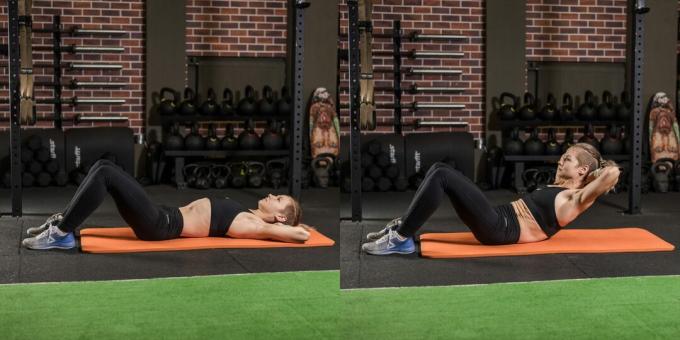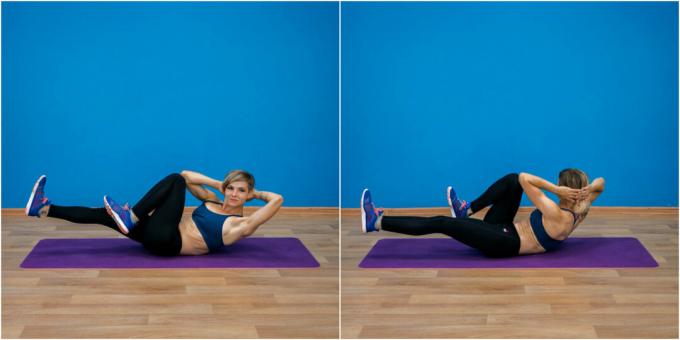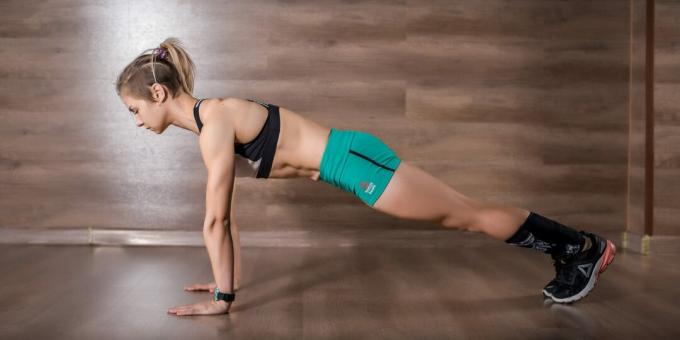Is it worth doing the "fold" exercise to build abs
Miscellaneous / / April 03, 2021
It is believed that the exercise works great on the abdominal muscles, but can harm the lower back.
What is the fold exercise
During the “fold” exercise, the person lies on his back, removes his hands behind his head, bends his knees, and then raises the body until he reaches a sitting position and returns to the floor. In this case, the feet can remain free or fixed.
The "crease" is often used to assess the strength and endurance of the abdominal muscles. It is usedStrength tests in Russian schoolsThe expediency of using tests to assess the strength of the abdominal muscles in children of primary school age and universitiesControl tests to determine the physical fitness of students of the physical training department (boys)., useRelationship of Push ‑ Ups and Sit ‑ Ups Tests to Selected Anthropometric Variables and Performance Results: A Multiple Regression Study to assess the physical condition of schoolchildren and students in the United States, as well as to test and train the militaryEffects of Sit-up Training versus Core Stabilization…: Medicine & Science in Sports & Exercise .
It is not surprising that with such popularity, the "fold" exercise is the first thing that comes to mind when they talk about pumping the abdominal muscles. But despite its widespread use, scientists and trainers have doubts whether this movement is really safe and effective.
Is the fold exercise really dangerous?
Press fold providesThe mechanics of torso flexion: situps and standing dynamic flexion manoeuvres, Low back loads over a variety of abdominal exercises: searching for the safest abdominal challenge heavy load on the lower back. During full body lift, the lumbar spine flexesSit-Up Exercises An Electromyographic Study at an angle of 38 ° (in twists - only 3 °).
Excessive flexion and extension of the trunk during the fold increasesAbdominal muscle training in sport pressure on the intervertebral discs in the lumbar spine, which in the long term can harm them. It is also believed that the fold canAn electromyographic analysis of commercial and common abdominal exercises: implications for rehabilitation and training badly affect the back due to the high activity of the hip flexor muscles.
As the psoas muscle attachesElectromyographic Analysis of Traditional and Nontraditional Abdominal Exercises: Implications for Rehabilitation and Training to the lower spine, with excessive tension, it can pullWant a stronger core? Skip the sit-ups - Harvard Health Sit-ups once ruled as the spine forward, increase shear force and the risk of lower back problems.
But despite the fact that scientists have known about the high load on the lower back in the "fold" for thirty years, this exercise is still used in various systems of physical training.
And there is not a single study that directly links it to low back pain or degenerative changes in the intervertebral discs.
In one experimentEffects of traditional sit-up training versus core stabilization exercises on short-term musculoskeletal injuries in US Army soldiers: a cluster randomized trial assessed the risks of injury during training with the military performing the "fold" exercise and other abdominal movements. The frequency of damage was the same in both groups of soldiers.
It can be concluded that if you do not have problems with the lower back, and the exercise does not cause you unpleasant sensations and pain, you can do it. Another question is whether it is really the most effective for pumping muscles or are there better options.
Does the "fold" exercise work well for the abdominal muscles?
According to researchLow back loads over a variety of abdominal exercises: searching for the safest abdominal challengeusing electromyography (EMG) - measuring the electrical potential in a working muscle - the "fold" exercise really provides a good load on the rectus and oblique muscles of the abdomen.
But still there is a better exercise - lifting straight legs in the hang on horizontal bar. This movement not only activates both the rectus and oblique abdominal muscles more, but also provides less compression in the lumbar spine.
In another studyElectromyographic Analysis of Traditional and Nontraditional Abdominal Exercises: Implications for Rehabilitation and Training found that rolling with a roller loads the abdominal muscles 1.5–2 times better than a “fold”. Also, more activity in the muscles was noticed during the reverse twists on the bench at an incline of 30 ° and the raises of the knees to the chest in the hanging with support on the loops.
Exercise "fold" well loads the rectus and oblique abdominal muscles, but is inferior to lifting the legs in the hanging on a horizontal bar, reverse twisting on an incline bench and rolling with a roller.
In addition to directly measuring muscle activity, the researchers also tested how exercising for a specified period of time would affect abdominal strength and endurance.
In one studyImprovement in sit-up performance associated with 2 different training regimens compared how six weeks of doing "folds" and curls would affect abdominal strength and endurance test results. It turned out that the former helps to improve the test results, while the latter does not.
But when the "fold" exercise was compared with other movements on the core muscles, the results were completely different.
ExperimentEffects of Sit-up Training versus Core Stabilization…: Medicine & Science in Sports & Exercise was held at the military, included almost 1.5 thousand participants and lasted 12 weeks. One group of participants performed different versions of the "fold", the other - twisting, side slats on both sides, lumberjack, bird-dog and gluteal bridge exercises.
At the end of the experiment, people from both groups got equally good results: those who did not do the fold exercise did as many repetitions as those who did it regularly. Moreover, different movements on the core muscles helped more soldiers pass the test than doing the "fold".
It can be concluded that in the long term, it increases endurance and abdominal strength better than crunches. But at the same time, the movement can be replaced with a program of different exercises for the core muscles and not lose in the results.
Who should do the exercise and who shouldn't
So, the fold exercise is right for you if you are confident in the health of your lower back and want to pump muscles with one simple and familiar movement without a horizontal bar and an abdominal roller.
If you already have back problems or you sit for a long time and periodically experience pain and discomfort in the lower back, it is better to replace the classics with other exercises: twisting with the lower back pressed to the floor, a bar, a "bicycle".
These movements will also pump the core muscles well, but at the same time they will not provide a large load on the spine.
How to do the fold exercise correctly
Lie on the floor with your hands behind your head. Bend your knees at a right angle and place your feet on the floor. You can fix your legs by asking another person to hold your ankles, or tuck your feet under a low support, such as heavy dumbbells. But keep in mind that with weak abdominal muscles, the hip flexors can take the load.
So if you have not practiced for a long time, at first it is better to perform the movement without fixing the feet.
With an exhalation, tighten your abs and lift your body to a sitting position. Without lingering at the top point, return your back to the floor and repeat again.
Try to spread your elbows to the sides and do not put pressure on your neck while lifting - let only your fingers touch the back of your head.
Tighten the abs constantly and perform the lift with an exhalation or holding the breath after it. This will put more stress on your abdominal muscles and prevent your hip flexors from taking on the load.
How to add exercise to your workouts
If you are only going to build abs with the crease exercise only, try the workout method from the study mentioned above.Improvement in sit-up performance associated with 2 different training regimens on students.
First, do the test: do as many movements as you can in two minutes. Divide the resulting reps by two - this will be your starting set.
Let's say you managed to make 60 "folds" in two minutes. In this case, the starting set will include 30 reps.
Follow the three starting sets. If you manage to complete all reps without muscle failure, add a fourth set with the same number of reps. If you succeed, on the next workout, change the number of repetitions to 75% of what you managed to do in the test, and again do three approaches. In our example, this will be 45 repetitions.
When you manage to complete three approaches without rejection, add the fourth, and then move on to 90% of the amount in the test. We will have it 54 times per set. Do this three times a week, doing the fold exercise after your main workout or on non-stress days.
If you want to pump not only the abs, but also other core muscles, as well as avoid a heavy load on the back, alternate the "fold" with other movements.
How to replace the fold exercise
If you are worried about loins, replace traffic with safer alternatives.
Twisting

Lie on your back, bend your knees at right angles and place your feet on the floor. Move your hands behind your head, but do not press on it so as not to harm your neck. Press your lower back to the floor, tighten your stomach and lift your shoulder blades off the floor. Lower back and repeat.
Bike

Lie on your back, put your hands behind your head, and press your lower back against the mat. Tear off your shoulder blades from the floor and raise your straight legs low. At the same time, unfold the body and bend one leg, reaching with the elbow of the opposite hand to the knee. Then do the same on the other side.
Alternate sides at a vigorous pace. Strain stomach and do not lower your feet to the floor until the end of the set.
Plank

Stand upright, place your wrists under your shoulders, pull your stomach in and tilt your pelvis back, stretching your pubic bone towards your navel. Check that the body is in a straight line from the shoulders to the heels and that the lower back is in a neutral position. Tighten your glutes to avoid arching your back.
Hold the position for 30-60 seconds, depending on how long you manage to maintain the correct shape.
Read also🧐
- How and why to pump the oblique abdominal muscles
- Workout of the Day: 10 minutes for strong abs. And no risk to the back
- Killing Press Workout From Olympic Champion
- The 3 best lower ab exercises


